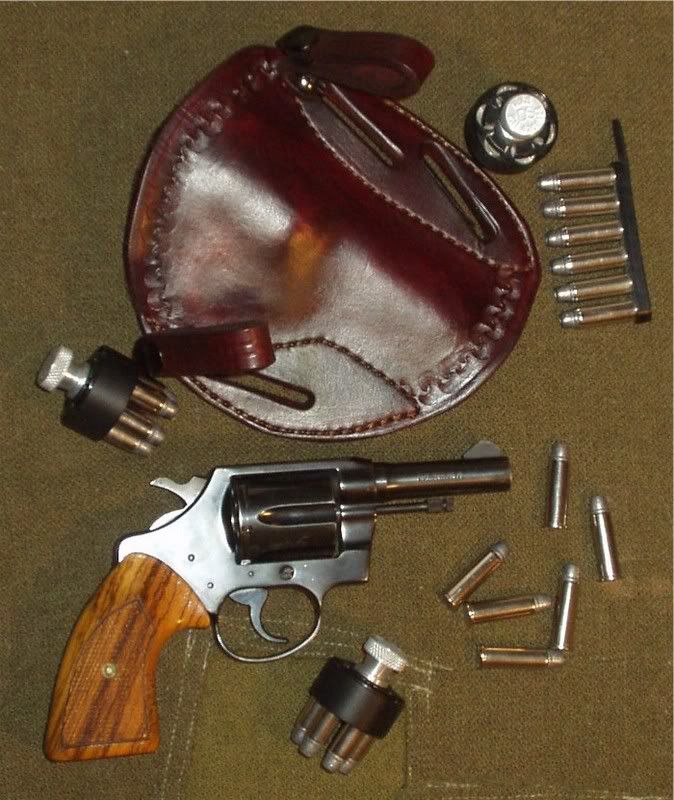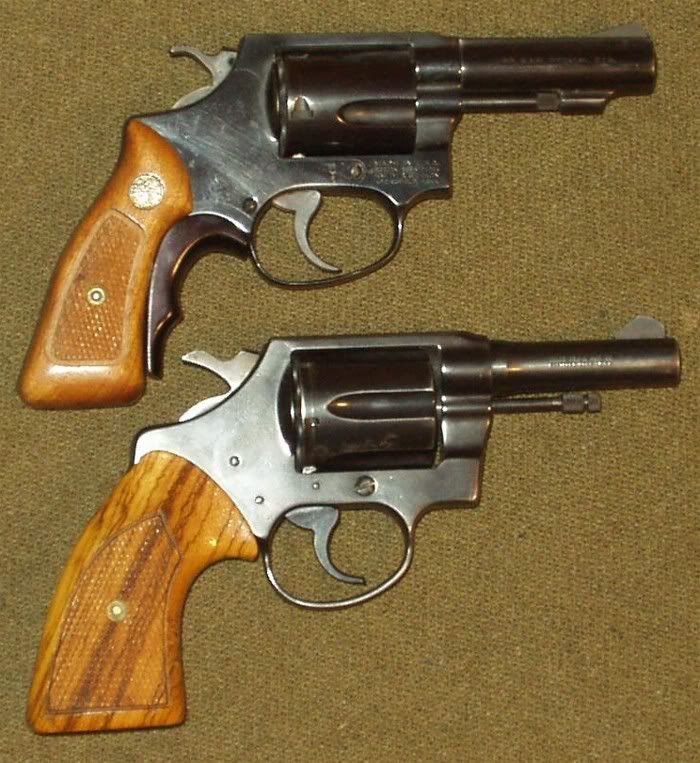 I've posted about this gun before today but I'll take the opportunity to sum up my experiences to date.
I've posted about this gun before today but I'll take the opportunity to sum up my experiences to date.I bought a 3" Colt Detective Special which serial number places its date of birth in 1972. This means that it has the short post '66 grip frame. Finish is about 80-85% but that is, of course, a subjective thing. It has holster wear on the finish at the muzzle and was clearly placed on one side in a drawer, perhaps a damp drawer, for a long period as there is some missing bluing on one portion of the cylinder. It arrived in my hands with Pachmayr rubber grips that seemed to detract from the beauty of this gun and I immediately went searching for more appropriate grips.
This took me places I'd rather not have gone and I acquired some Herrett's grips more suited to the Police Positive Special, an abortive pair of Ajax grips and was finally given the best of the lot, another pair of Herrett's more moderately bulky than my never installed pair. I like this pair best and it is the pair shown installed.
Acquisition of speed loaders for this revolver was no problem at all and I now have 3 of the HKS speed loaders intended for the Detective Special. However, if you must, the K-frame speed loaders will also work and this was a major attraction of the Detective Special, it being a good, smaller, lighter back-up to the K-frame S&W service revolvers.
I needed leather for the gun as well but wasn't certain that I'd want to carry IWB all the time but realized that this gun would demand an IWB holster a good bit of the time. Rob Leahy of Simply Rugged came through with one of his inside out modifications to the Silver Dollar pancake holster. This works a treat and is comfortable in either carry mode. I've even worn the gun IWB when hunting with comfort! That is the holster shown in the photo and it looks good, too!
But what ammo to use? Well, it is a 1972 gun. I like that it is as light as the S&W M36 but has the extra chamber in the cylinder giving me one more round before reloading. I think that this late a gun can use limited use of the +P loadings, namely the FBI load. Most of the time, I would expect that 4.5 gr. of Unique under a swaged or cast 158 gr. SWC (HP or not) will meet most requirements.
I guess I'm lucky in that this fixed sight gun shoots close enough to point of aim for practical use with these loads to 25 yards (small game) or even 50 yards (anti-personnel). However, I would not likely be shooting at anyone further than about 30-40 feet. It is comforting that I could take any necessary shot at that range.
 How does the Detective Special compare to the S&W M36 3". Well, they don't vary in weight by more than a couple of ounces, loaded. Their dimensions aren't that different for length. However, the cylinders are enough different in diameter and the frames enough different in depth (top to bottom) that they can't share a holster. Also, that 6th shot in the Detective Special is comforting. I will say though that the heavier barrel of the 3" M36 "hangs" better than the Detective Special.
How does the Detective Special compare to the S&W M36 3". Well, they don't vary in weight by more than a couple of ounces, loaded. Their dimensions aren't that different for length. However, the cylinders are enough different in diameter and the frames enough different in depth (top to bottom) that they can't share a holster. Also, that 6th shot in the Detective Special is comforting. I will say though that the heavier barrel of the 3" M36 "hangs" better than the Detective Special.One thing that is seldom mentioned, particularly by shops that might be selling the Detective Specials, is that service support for the guns is rapidly going away. Few gunsmiths will work on them, the factory won't/can't supply parts or service. For some that is a deal breaker. I will continue to carry mine, but, I will carefully ration the number of rounds it fires.
Since getting this gun, I've bought a couple of other D-frames and a J-frame Colt. Information on checking out these guns is important to the buyer of used revolvers, which all are. So, I thought I'd include the following information (courtesy of Dfariswheel).
To check Colt timing:
BOLT RETRACTION AND "SNAP BACK".
Open the cylinder and look at the small "lug" in the bottom of the cylinder window. This is the cylinder locking bolt.
Cock the hammer, and watch as the bolt retracts into the frame and pops back out.
The bolt MUST begin to retract THE INSTANT the hammer begins to move. There MUST be NO (ZERO) hammer movement possible before the bolt starts to retract.
The bolt should retract smoothly with no hesitation until it's fully retracted, then it MUST pop back out with a clean "snap".
There should be no hesitation, and no amount of "creeping" back out.
CYLINDER UNLOCKING.
Close the cylinder.
Use your left thumb or fore finger to again cock the hammer, closely watching the cylinder bolt as you SLOWLY cock the hammer.
As the hammer comes back, the bolt will retract away from the cylinder.
The bolt MUST retract far enough to unlock the cylinder BEFORE the cylinder begins to rotate.
If the bolt is still slightly engaged with the cylinder lock notch, the cylinder will be attempting to turn while still partially locked.
This produces a "catch" or "hard spot" in the trigger pull and will damage both the bolt and the cylinder lock notches. This often appears as metal "pulled out" of the lock notches, with rounded off and burred notches.
BOLT DROP TIMING.
Continue to cock the hammer, laying your right index finger on the cylinder just enough to prevent "free wheeling".
Watch for the bolt to drop back onto the cylinder. WHERE the bolt drops is CRITICAL.
The bolt MUST drop onto the lead or ramp in front of the actual cylinder notch.
If the bolt drops too soon, (in front of the notch ramp), it will mar the finish of the cylinder.
The bolt SHOULD drop into the MIDDLE 1/3rd section of the ramp.
If the bolt drops late, (farther toward the actual locking notch) the revolver may display "cylinder throw-by".
In this condition, during double action shooting the cylinder may rotate PAST the locking notch, and fire in an unlocked condition.
It's the nature of the Colt action, that a hesitant or jerky trigger pull by the user can induce throw-by in even a properly tuned Colt.
The Colt trigger should be pulled with a smooth, even pull, with no sudden jerks at the beginning.
CYLINDER LOCKUP.
Continue to pull the hammer back and both watch and listen for the bolt to drop into the cylinder lock notch.
The bolt MUST drop into the actual lock notch BEFORE the hammer reaches full cock.
The most common Colt mis-time situation is the hammer cocks before the bolt drops into the lock notch. (Hammer is cocked, but cylinder isn't locked).
In this condition, with the hammer fully cocked, you can push the cylinder slightly, and you will hear the "CLICK" as the bolt drops into lock.
In my experience, most Colt's leave the factory with the bolt dropping a little late into the lead, but usually wear in to correct timing.
If the bolt drops onto the cylinder early, no real problem, but there will be extra finish wear.
If the bolt drops late (closer to the lock notch) the cylinder may "throw by" or rotate TOO far in double action and this can cause off-center primer hits and firing while unlocked.
Each of these checks should be done on EACH chamber. All of these checks are better done individually. In other words, do the bolt retraction check on all six chambers, then do the bolt drop test, and so on.
A properly tuned Colt will: Have a smoothly functioning bolt with no sticky or hesitant movement.
Unlock before the cylinder begins to turn.
The bolt will drop onto the middle 1/3rd of the ramp.
The bolt will drop into the lock notch before the hammer reaches full cock.
Have a smooth trigger pull, which does "stack" or get progressively heavier.
Links:
- The Classic Colt Detective Special .38 Revolver By Mike Guffey
No comments:
Post a Comment
I only ask that you keep it clean and not spam readers. Thanks.